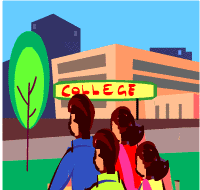
Learning to Teach [Illustration by Shiju George]
“It’s a movement,” points out Dr Asha Mathur. And she ought to know, as vice principal of Lady Shri Ram College for Women (LSR) and programme co-ordinator for the Bachelor of Elementary Education (B.EI.Ed.) course, recently been introduced by the college.
The four-year integrated professional degree programme was already under way at Jesus & Mary, Gargi, Vivekanand, Shyama Prasad Mukherjee colleges and Aditi Mahavidyalya when LSR decided to include the subject.
The efforts by these colleges have improved prospects for students who opt for this field. Offered by Delhi University, this is the first such professional course.
The programme concentrates on training professionals for elementary education. This group was singled out since it was felt that while the Bachelor of Education or B.Ed. course normally addresses higher classes, there are other training programmes for teacher of very young students.
As Dr Mathur notes, students between these two groups are often not taught by teachers trained specifically for them. “Classes first to fifth is really the time when children need the teacher’s attention. After that, they get into the schooling system,” explains Dr Mathur.
The B.EI.Ed. programme also differs in its thrust. An integrated course, it is ‘child- centric’ in approach and therefore, the stress is not on methodology.
“Pedagogy is a concern, but teaching, in the traditional sense, is not the focus of the course,” she explains. These students are taught the importance of working out what the children can cope with.
Since students opt for this programme right after class XII, it is a combined curriculum — a graduation programme plus a teacher training programme — with no separate year earmarked for teaching. This makes the course more focussed since it gives the students enough time to study children — four years for retrospection and discussion and interaction with teachers.
As the curriculum indicates, the students are put through 19 theory courses, eight practical courses, four tutorials, academic enrichment activities and a project.
Although the students are introduced to actual classroom situations from the first year of study, the involvement is graded. “In the first year, it is just interaction,” explains Dr Mathur.
Already, discussions are on for the students to visit schools on occasional Saturdays so that the school calendar is not upset, while they are exposed to student behaviour.
This is also the time when they study the basics of child development, and at the same time take on core courses in language, social science, natural science and mathematics.
To improve their communication skills, they are regularly exposed to crafts and the performing arts so that by the time they move on to teach, they are comfortable in switching from the verbal form of communication to any other which may facilitate learning.
In the second year, they observe the students closely. While they observe the classroom scenario, the students are introduced to the working of the child’s mind and even physical education. At the same time, studies continue in language, communication and one optional subject.
The next year, they are introduced to classroom management. With basic concepts in education, this is the time when the administration of a school, often neglected in other courses, is explained.
“Finally, by the fourth year, you are into teaching, or internship, you understand how a child works, how a child interacts in groups, individually and socially,” sums up Dr Mathur. Issues like curriculum and gender are dealt with at this time.
There is also an option, during the last year, of taking up computer education or education for special children. Finally, there is the school internship programme. “Since the stress in this course is on the child, there is a basic difference in this course,” she asserts.
Certainly a new concept, the course raises questions about certain established ideas. Does a teacher who has not studied specified subjects in college, have a strong grasp of the subjects?
“When you talk of a child in the first standard, you wouldn’t want a narrow, specialised approach. Knowledge has to be broad-based,” argues Dr Mathur. “Compartmentalised knowledge is not required (for lower classes)”. Different subject teachers, she believes, can curtail a child’s inquisitive spirit.
But what about the higher classes, since these teachers will be expected to address students up to class VIII? She admits, after some thought, that it is limited knowledge in one sense since they won’t have “that kind of knowledge” about a single subject.
On the other hand, they are exposed to a number of subjects. With four years to graduation, the course ensures that future teachers devote a good deal of their college time to their profession.
In a regular teacher training course, this period of study is certainly curtailed. In fact, there is time to use the knowledge in school and follow it with discussions with the faculty and other students.
“This course opens the mind. Since it does not have a narrow perspective, all skills are honed simultaneously,” explains Dr Mathur.
Since this course is at par with the Pass course, students interested in further study have recently been permitted to move on to a Master’s degree in Education, the Arts or even Mass Communication. After an M.Ed.– which will take them an extra year to complete — they can work on educational policy, a field that requires considerable attention.
In fact, none of the five of LSR’s first batch of 19 trainees rated teaching as their first choice, with policy planning holding their fascination. “Education is a vast field,” believes Gunjan Khosla, who sees herself working in curriculum planning.
In the field of school employment, too there are hurdles that have to be overcome. One of these is salary. Dr Mathur believes these students should be paid more than other teachers, but that is yet to be.
However, as Dr Mathur pointed out, changing mindsets at every level, including those of some students about teaching at NDMC schools, is perhaps the biggest challenge for the course. “Five years down the line, there should be a change,” she foresees, since the response of the class has been encouraging in just a month.
Certainly, the faculty looks forwards to the day when more students will opt for this course for the love of teaching and when they will be as interested in putting their learning to practice in the classroom as they are now in board rooms.
As she proclaims, introducing B.EI.Ed. is not just launching a course, it is starting a movement.










